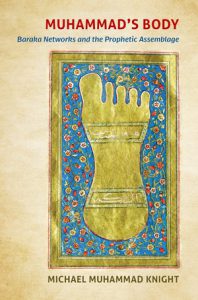
Assistant professor Michael Muhammad Knight has recently written a new book, published by the University of North Carolina Press. Titled Muhammad’s Body: Baraka Networks and the Prophetic Assemblage, the book conceives a different understanding of the Prophet Muhammad’s body as it relates to the construction of prophetic masculinity and authority. Changing representations of the Prophet’s body helped to legitimatize certain types of people or individuals as religious authorities, while marginalizing or delegitimizing others. For some Sunni Muslims, Knight concludes, claims of religious authority today remain connected to ideas about Muhammad’s body.
When asked how the book came to be, Knight said “I was starting to wander in the hadith corpus, the collected statements and actions of the Prophet Muhammad. Most of the academic conversation around hadith literature was concerned with variations on the ‘authenticity question,’ that is, the problem of whether these sources are historically reliable and can give us the ‘real’ Muhammad. I wasn’t interested in that question so much as I wanted to think about how the thousands of Muslim scholars who compiled this literature thought about Muhammad and constructed him in the process of making the archive. I wanted to ask different questions rather than ‘Is this real or not?’ There’s a nascent study of Muslim masculinities and some theoretical engagement of hadith, and standing at the intersection of hadith studies and gender studies really brought me to center the Prophet’s body in my questions.”
Knight hopes to show readers the multiplicity of Islamic geographic, cultural, sectarian, and methodological contexts in understanding the question “What does Islam say about the body?” “People imagine something like the hadith corpus, or Islam at large, as a singular undifferentiated monolith that only speaks with one collective voice. My hope is that I dismantle the question rather than answer it. There is no answer,” says Knight. “Islam is multiplicity, it’s heterogeneity, it’s internal diversity, and this all finds reflection in the creative messiness of how Muslims envision Muhammad’s body, its powers, and its limits.”